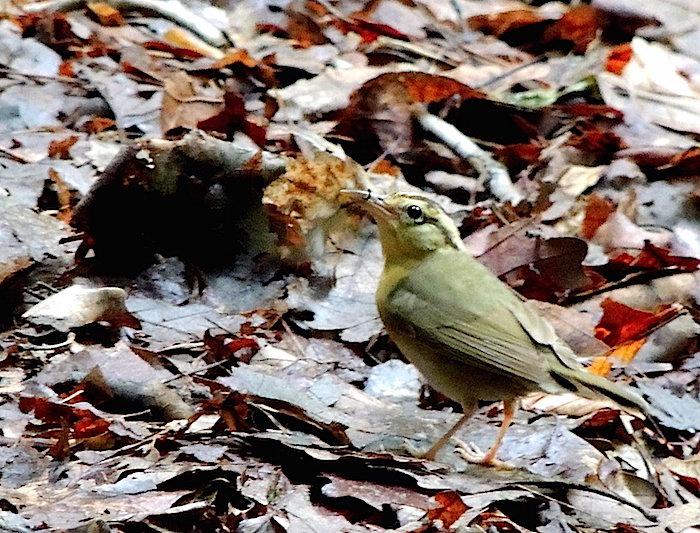
The Worm-eating Warbler is one of several varieties of warbler that spend time at Mammoth Cave National Park/Kirby Adams
Caves aren’t the best places to go birding. Sure, birders will gladly watch (and list!) a bat when the birding is slow - they do have wings, after all. Still, the birding tends to be much better above ground. So, a birder would be forgiven for not considering Mammoth Cave National Park a great birding destination, but that birder would be mistaken.
Mammoth Cave, of course, includes all of the ground above the cave, and that ground is covered with a rolling mixed deciduous forest and the meandering Green and Nolin rivers. Look at a satellite map of western Kentucky and the park jumps out as prime habitat -– an uninterrupted tract of forest amid the state’s famous farms and pastures.
Northern birders venture down to Mammoth Cave with warblers on the brain. Cerulean Warblers are one of the park’s signature birds. Declining in population, and severely threatened by habitat loss on their wintering grounds in South America, Ceruleans are holding up well at Mammoth Cave. They aren’t an easy bird to see in the dense forest, as they prefer the canopy. A birder needs to know the bird's distinctive song, and then spend a while looking straight up to catch a glimpse of blue. With luck, a Cerulean Warbler will appear at eye level, but more often than not the birder on the hunt for them goes home with a case of “warbler neck” in exchange for the sight of an uncommon and unquestionably beautiful bird.
Another typical target bird at Mammoth Cave would be the aptly named Kentucky Warbler. As with Ceruleans, the Kentucky doesn’t give up views too easily. Kentuckys tend to forage on the ground or near the ground, making the hunt for them a little easier on the neck, but sometimes just as frustrating as the Ceruleans.
The third of the southern warbler trio to be found at Mammoth Cave is the Worm-eating Warbler. Unlike the Kentucky, the “wormie’s” name is not accurate at all. Its food of choice are tiny insect larvae, not worms, but being a ground nester they have apparently become associated with worms.
Outside of the nesting season, Mammoth Cave sees spectacular songbird migration in both spring and fall. Thanks to the efforts of a long-time park volunteer, the public can get free guided bird walks through the fall migration period.
A 12-year veteran of guiding cave tours at the park, Steve Kistler decided to stick to the surface this year. What had been just a couple bird walks annually turned into three walks every week for ten weeks in the spring. The results were so good, he’s offering two walks a week this fall.
A life-long birder and a Kentuckian for four decades, Kistler is wrapping up a run as president of the Kentucky Ornithological Society. Volunteering to do the bird and plant walks gets him out in nature, but the park patrons are a pleasant bonus.
“I get to interact with nature lovers from around the country and the world,” he says, reflecting on the success of the spring walks.
Most of the birders want to see the specialty Southeastern warblers or other common Southeastern birds that are abundant in the park, like Summer Tanagers and Wood Thrushes. But not everyone who joins the walks is a birder. As a retired science teacher, Kistler is in tune with what the kids and families like to see. The clearing by the visitor center presented a fan-favorite this breeding season.
“A pair of Eastern Bluebirds nested in a dogwood tree, and we were able to show lots of families the babies,” Kistler says, adding that Pileated Woodpeckers also tend to steal the show. “The Heritage Trail is especially good for them. If they’re busy feeding on fallen logs, they’ll let you sneak up pretty close.”
The bird walks will be Tuesdays and Thursdays (excluding Sept. 3) at 8:15 a.m. at the Visitor Center. They’re free to join and no registration is required. Stick around for plant walks at 11 a.m. on the same days.
Kistler has a message for any seasoned birders who may be around Mammoth Cave this fall. “Come join in and help me teach birds to kids. They always enjoy it and you probably will too!”
You can contact Steve Kistler at [email protected] for more information.
Finally, if you see some fabulous Cerulean Warblers at Mammoth Cave and want to know how you can help them make it through the winter to come back again next spring, check out options for bird-friendly coffee. Ceruleans and many other birds winter in areas heavily used as coffee plantations. When rainforest is cleared for sun-demanding cultivars of coffee plants, the birds lose habitat. Shade-grown coffee utilizes coffee plants grown under a forest canopy, allowing birds and coffee to live in harmony!



Add comment